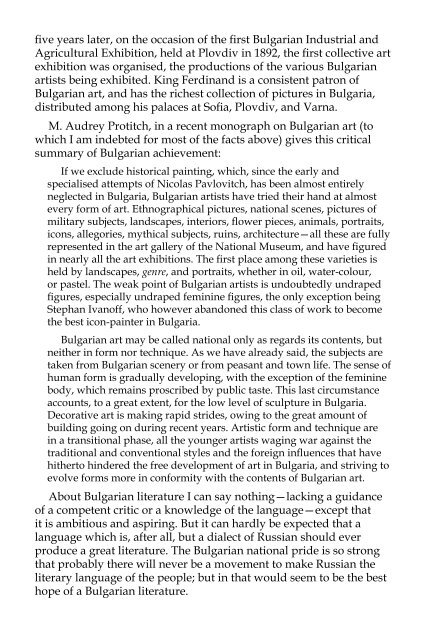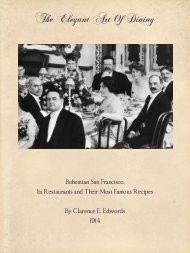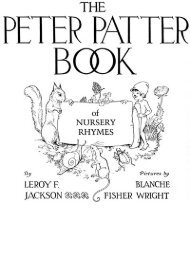Bulgaria e-book - iMedia
Bulgaria e-book - iMedia
Bulgaria e-book - iMedia
You also want an ePaper? Increase the reach of your titles
YUMPU automatically turns print PDFs into web optimized ePapers that Google loves.
five years later, on the occasion of the first <strong>Bulgaria</strong>n Industrial and<br />
Agricultural Exhibition, held at Plovdiv in 1892, the first collective art<br />
exhibition was organised, the productions of the various <strong>Bulgaria</strong>n<br />
artists being exhibited. King Ferdinand is a consistent patron of<br />
<strong>Bulgaria</strong>n art, and has the richest collection of pictures in <strong>Bulgaria</strong>,<br />
distributed among his palaces at Sofia, Plovdiv, and Varna.<br />
M. Audrey Protitch, in a recent monograph on <strong>Bulgaria</strong>n art (to<br />
which I am indebted for most of the facts above) gives this critical<br />
summary of <strong>Bulgaria</strong>n achievement:<br />
If we exclude historical painting, which, since the early and<br />
specialised attempts of Nicolas Pavlovitch, has been almost entirely<br />
neglected in <strong>Bulgaria</strong>, <strong>Bulgaria</strong>n artists have tried their hand at almost<br />
every form of art. Ethnographical pictures, national scenes, pictures of<br />
military subjects, landscapes, interiors, flower pieces, animals, portraits,<br />
icons, allegories, mythical subjects, ruins, architecture—all these are fully<br />
represented in the art gallery of the National Museum, and have figured<br />
in nearly all the art exhibitions. The first place among these varieties is<br />
held by landscapes, genre, and portraits, whether in oil, water-colour,<br />
or pastel. The weak point of <strong>Bulgaria</strong>n artists is undoubtedly undraped<br />
figures, especially undraped feminine figures, the only exception being<br />
Stephan Ivanoff, who however abandoned this class of work to become<br />
the best icon-painter in <strong>Bulgaria</strong>.<br />
<strong>Bulgaria</strong>n art may be called national only as regards its contents, but<br />
neither in form nor technique. As we have already said, the subjects are<br />
taken from <strong>Bulgaria</strong>n scenery or from peasant and town life. The sense of<br />
human form is gradually developing, with the exception of the feminine<br />
body, which remains proscribed by public taste. This last circumstance<br />
accounts, to a great extent, for the low level of sculpture in <strong>Bulgaria</strong>.<br />
Decorative art is making rapid strides, owing to the great amount of<br />
building going on during recent years. Artistic form and technique are<br />
in a transitional phase, all the younger artists waging war against the<br />
traditional and conventional styles and the foreign influences that have<br />
hitherto hindered the free development of art in <strong>Bulgaria</strong>, and striving to<br />
evolve forms more in conformity with the contents of <strong>Bulgaria</strong>n art.<br />
About <strong>Bulgaria</strong>n literature I can say nothing—lacking a guidance<br />
of a competent critic or a knowledge of the language—except that<br />
it is ambitious and aspiring. But it can hardly be expected that a<br />
language which is, after all, but a dialect of Russian should ever<br />
produce a great literature. The <strong>Bulgaria</strong>n national pride is so strong<br />
that probably there will never be a movement to make Russian the<br />
literary language of the people; but in that would seem to be the best<br />
hope of a <strong>Bulgaria</strong>n literature.<br />
Chapter XI<br />
How <strong>Bulgaria</strong> is Governed<br />
To attempt to describe how <strong>Bulgaria</strong> is governed is to enter<br />
inevitably into the realms of controversy. In theory the system of<br />
government is purely democratic: and many <strong>Bulgaria</strong>ns are confident<br />
that the practice follows the theory closely. Personally I have my<br />
doubts. The working of a fully democratic constitution seems to be<br />
tempered a great deal by the aristocratic powers reserved to the King<br />
in Council at times of crisis: and this tempering is probably necessary.<br />
The ancient <strong>Bulgaria</strong>n system of government was without a<br />
doubt the despotic tribal system of nomads. Under Turkish rule, the<br />
territory of <strong>Bulgaria</strong> was administered as the Vilayet of the Danube<br />
under a Turkish Pasha; and not always badly administered as is<br />
proved by the fact that <strong>Bulgaria</strong>n industry and thrift was allowed to<br />
raise the province into the most flourishing one of Turkey-in-Europe.<br />
But until the Treaty of Paris in 1856, Turkey had no real political<br />
organisation. Being a theocratic state, all her public institutions<br />
emanated from the Kaliph, as the representative of Mohammed.<br />
The Koran took the place of civil and criminal law, and the duty of<br />
its ministers was to punish all those who broke its commandments.<br />
Every parish had a “cadi,” who was appointed by the spiritual<br />
chief. The cadi concentrated in his hands all jurisdictions, judging<br />
without appeal cases, civil and criminal, and observing no fixed<br />
rules of procedure in the application of the few principles which the<br />
Koran contained on the subject of civil relations. In certain special<br />
cases, the Sheik-ul-Islam of Constantinople, the highest religious<br />
tribunal in Turkey, had the right to revise the decisions of the<br />
cadis. At the Congress of Paris, Turkey, as one of the participating<br />
parties, was admitted into the concert of European Powers. Then<br />
civil tribunals were for the first time created in Turkey. In 1867 they<br />
were introduced in the Vilayet of the Danube by the then Governor-<br />
General, Midhat Pasha. In 1877 the Russians liberated <strong>Bulgaria</strong><br />
from the Turks. After the Treaty of Berlin Prince Dondoukoff-<br />
Korsakoff framed a provisional system of government for <strong>Bulgaria</strong>.<br />
Then a Russian law professor, Gradovsky, with the help of<br />
General Domontovity, framed a constitution for <strong>Bulgaria</strong>. This was<br />
based upon the commune being, as in Russia, the organic unit of<br />
administrative control, and was aristocratic rather than democratic in





